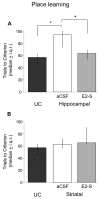Estrogen modulates learning in female rats by acting directly at distinct memory systems
- PMID: 17052857
- PMCID: PMC1931581
- DOI: 10.1016/j.neuroscience.2006.09.002
Estrogen modulates learning in female rats by acting directly at distinct memory systems
Abstract
Physiologically high levels of circulating estradiol enhance the use of place learning and impair the use of response learning to find food on a land maze. These two types of learning are impaired by lesions of distinct neuronal structures, i.e. the hippocampus and striatum, respectively. Moreover, it has been shown in male rats that compromising hippocampal function can promote the use of response learning, while compromising striatal function can promote place learning. These findings suggest an ongoing competition between the hippocampus and striatum during cognition, such that intact functioning of one structure somehow obstructs the relative participation of the other. The goal of this study was to determine if estrogen's opposing effects on place and response learning in female rats are due to direct actions, either independent or interacting, at the hippocampus and striatum. We infused 0.5 microM 17beta-estradiol 3-sulfate sodium or vehicle bilaterally into the dorsal hippocampus or dorsolateral striatum of ovariectomized young adult female rats, 48, 24 and 2 h before training. Rats were tested on one of three appetitive tasks in a Y-maze: place learning, response learning, or response learning with reduced visual cues (cue-poor condition). Intrahippocampal estradiol infusions enhanced place learning, reversing a cannula-induced impairment, whereas intrastriatal infusions had no effects on place learning. Estradiol infusions into neither structure significantly affected response learning when extramaze cues were visible. However, in the response task, cue-poor condition, intrastriatal but not intrahippocampal infusions impaired learning. These data demonstrate that estrogen modulates place and response learning at the hippocampus and striatum respectively, most likely through independent actions at these two structures.
Figures




References
-
- Amaral DG, Witter MP. Hippocampal formation. In: Paxinos G, editor. The rat nervous system. San Diego: Academic Press; 1995. pp. 443–493.
-
- Ansonoff MA, Etgen AM. Estrogen increases G protein coupled receptor kinase 2 in the cortex of female rats. Brain Res. 2001;898:186–189. - PubMed
-
- Bazzett TJ, Becker JB. Sex differences in the rapid and acute effects of estrogen on striatal D2 dopamine receptor binding. Brain Res. 1994;637:163–172. - PubMed
-
- Becker JB. Direct effect of 17 beta-estradiol on striatum: sex differences in dopamine release. Synapse. 1990;5:157–164. - PubMed
-
- Becker JB. Gender differences in dopaminergic function in striatum and nucleus accumbens. Pharmacology, Biochemistry and Behavior. 1999;64:803–812. - PubMed
Publication types
MeSH terms
Substances
Grants and funding
LinkOut - more resources
Full Text Sources
Medical

